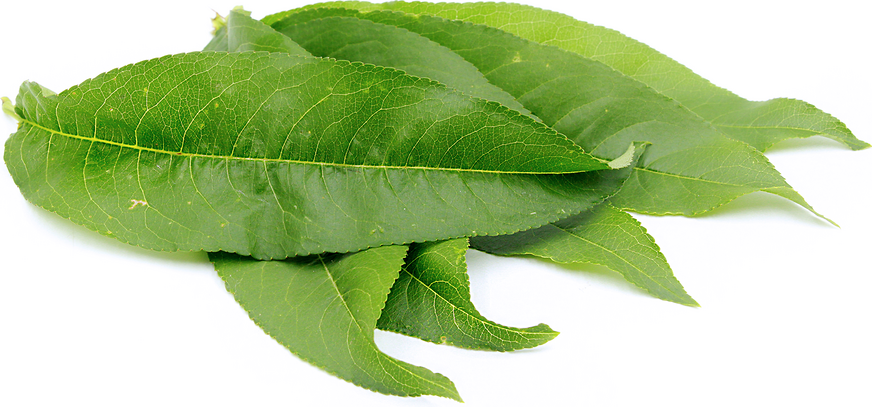


Peach Leaves
Estimated Inventory, lb : 0
Description/Taste
Peach leaves are small to medium in size and oval to lanceolate in shape, averaging 10-20 centimeters in length and 2-8 centimeters in width. The vibrant green leaves are smooth with serrated edges that taper to a point at the non-stem end, and there is a central midrib with many small veins branching across the surface. Peach leaves are slender and grow in an alternate pattern. They cannot be consumed raw, but when cooked, Peach leaves have a slightly bitter flavor with almond and floral undertones.
Seasons/Availability
Peach leaves are available spring through summer.
Current Facts
Peach leaves, botanically classified as Prunus persica, grow on a deciduous tree that can reach 5-10 meters in height and are members of the Rosaceae, or rose family. Peach leaves are often cooked and used as a flavoring agent in drinks and desserts. Raw Peach leaves should not be consumed as they contain amygdalin which turns into cyanide when it comes into contact with acids in the human digestive system.
Nutritional Value
Peach leaves contain some diuretic, laxative, and detoxifying properties.
Applications
Peach leaves must be cooked before consumption and are best suited for applications such as boiling and baking. They can be cooked and used as a flavoring in desserts such as ice cream, sorbets, pies, and crème brulee. Peach leaves are also used to make teas, wine, and prosecco. In addition to desserts and drinks, Peach leaves can also be boiled or dried and crushed and used in marinades, salad dressing, and sauces to flavor fish and chicken. Peach leaves pair well with honey, sugar, rose water, bay leaves, chicken, and salmon. They will keep for a couple of days when stored unwashed and in a plastic bag in the refrigerator.
Ethnic/Cultural Info
Peach trees are highly revered in cultures around the world and are known for their blossoms and fruits, but the leaves have also been used medicinally. In China, Peach leaves are boiled as a tea to help reduce symptoms of congestion and coughs and as a kidney cleanser. In Italy, Peach leaves are rumored to help remove warts from the skin. The belief is if the leaf is applied to the wart and then buried in the ground, the wart will disappear before the leaf can fully deteriorate.
Geography/History
Peaches are believed to be native to China and have been cultivated since ancient times. They were then brought to the Mediterranean and Persia via the silk road around 2,000 BCE and continued to spread via explorers and trade routes. Today Peach leaves can be found at specialty markets in Asia, the Middle East, the Mediterranean, Australia, and the United States.
Recipe Ideas
Recipes that include Peach Leaves. One
| Story of a Kitchen |
|
Peach Leaf Crème Brûlée |
| Holistic Health Herbalist |
|
Peach Leaf Tea |




